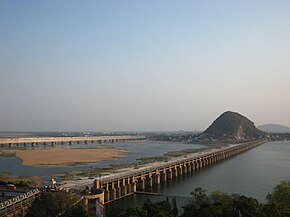Hampi: The ruins of Karnataka's magnificent past
Hampi is a village in northern Karnataka state, India. Hampi is located within the ruins of Vijayanagara, the former capital of the Vijayanagara empire. Possibly predating the city of Vijayanagara, this village continues to be an important religious centre, housing the Virupaksha Temple. The village of Hampi contains several other monuments belonging to the old city. It extends into some of the old ceremonial streets of Vijayanagara. As the village is at the original centre of Vijayanagara, it is sometimes confused with this ruined city. The Vijayanagara ruins are listed as the Group of Monuments at Hampi as a UNESCO World Heritage Site.
Hampi is located within the ruins of Vijayanagara, the former capital of the Vijayanagara empire. Possibly predating the city of Vijayanagara, this village continues to be an important religious centre, housing the Virupaksha Temple. The village of Hampi contains several other monuments belonging to the old city. It extends into some of the old ceremonial streets of Vijayanagara. As the village is at the original centre of Vijayanagara, it is sometimes confused with this ruined city. The Vijayanagara ruins are listed as the Group of Monuments at Hampi as a UNESCO World Heritage Site.
Hampi, as it is popularly known today was the medieval capital of the Hindu empire Vijayanagara (the City of Victory).

 The woods are lovely, dark and deep,
But I have promises to keep,
And miles to go before I sleep,
And miles to go before I sleep.
The woods are lovely, dark and deep,
But I have promises to keep,
And miles to go before I sleep,
And miles to go before I sleep.
 The River Krishna, meaning "dark" (feminine) in Sanskrit, also called the Krishnaveni is one of the longest rivers of India, which is about 1300 km in length.Krishna River originates in the Western Ghats at an altitude of about 1300 above sea level in Mahabaleshwar, about passes through Sangli and conjoins the sea in the Bay of Bengal at Hamasaledevi in Andra Pradesh. It flows through the states of maharashtra, Karnataka and Andra Pradesh.
The River Krishna, meaning "dark" (feminine) in Sanskrit, also called the Krishnaveni is one of the longest rivers of India, which is about 1300 km in length.Krishna River originates in the Western Ghats at an altitude of about 1300 above sea level in Mahabaleshwar, about passes through Sangli and conjoins the sea in the Bay of Bengal at Hamasaledevi in Andra Pradesh. It flows through the states of maharashtra, Karnataka and Andra Pradesh. A pleasant retreat set amidst the lush forested hills. Mt. Abu is a green oasis in the barren dessertscape that’s Rajasthan.Situated at the southern tip of the Aravali range, the hill retreat owes its cool climate to its rich flora covering the entire hillside that includes coniferous trees and flowering shrubs. During the British rule in India, it was rewarded as the favorite leisure destination of the British, who came here to escape the dusty, dry heat of the desert. Mount Abu is noted as the only hill station in solid gold of Rajasthan, its a popular summer temptation for millions of tourists to escape heat and dust of Rajasthan.
A pleasant retreat set amidst the lush forested hills. Mt. Abu is a green oasis in the barren dessertscape that’s Rajasthan.Situated at the southern tip of the Aravali range, the hill retreat owes its cool climate to its rich flora covering the entire hillside that includes coniferous trees and flowering shrubs. During the British rule in India, it was rewarded as the favorite leisure destination of the British, who came here to escape the dusty, dry heat of the desert. Mount Abu is noted as the only hill station in solid gold of Rajasthan, its a popular summer temptation for millions of tourists to escape heat and dust of Rajasthan. The Bhabha Atomic Research Centre (BARC) is India's primary nuclear research facility. .It has a number of nuclear reactors, all of which are used for India's nuclear power and research programme.
The Bhabha Atomic Research Centre (BARC) is India's primary nuclear research facility. .It has a number of nuclear reactors, all of which are used for India's nuclear power and research programme. The deodar is one of the world’s four varieties of cedars and it is found in the Himalayas at heights between 1000 m and 3000 m above mean sea levelThe tree takes roots during spring as the saplings come up after winter. The small tree is just a slender stem; it takes years before the tree grows to its full height and thickness. A full-grown tree can have a girth of 15 to 20 feet; in height it rises, spreading its branches like huge arms on either side of the trunk, to around 200-250 feet. This full-grown tree is the mature deodar or the Himalayan cedar, with the botanical name cedrus deodara. A mature tree bears both male and female cones. These are initially soft and silvery green. They darken with age and become wooden when dry
The deodar is one of the world’s four varieties of cedars and it is found in the Himalayas at heights between 1000 m and 3000 m above mean sea levelThe tree takes roots during spring as the saplings come up after winter. The small tree is just a slender stem; it takes years before the tree grows to its full height and thickness. A full-grown tree can have a girth of 15 to 20 feet; in height it rises, spreading its branches like huge arms on either side of the trunk, to around 200-250 feet. This full-grown tree is the mature deodar or the Himalayan cedar, with the botanical name cedrus deodara. A mature tree bears both male and female cones. These are initially soft and silvery green. They darken with age and become wooden when dry